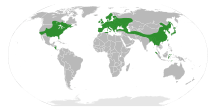Ulmaceae
| Ulmaceae | |
|---|---|
 | |
| Ulmus laciniata Morton Arboretum acc. 180-84-1 | |
| Scientific classification | |
| Kingdom: | Plantae |
| (unranked): | Angiosperms |
| (unranked): | Eudicots |
| (unranked): | Rosids |
| Order: | Rosales |
| Family: | Ulmaceae Mirb. |
| Genera | |
|
Ampelocera Klotzsch | |
 | |
| The range of Ulmaceae. | |
The Ulmaceae /ʌlˈmeɪsiː/ are a family of flowering plant that includes the elms (genus Ulmus), and the zelkovas (genus Zelkova).[1] Members of the family are widely distributed throughout the north temperate zone, and have a scattered distribution elsewhere except for Australasia.[2][3]
The family was formerly sometimes treated to include the hackberries, (Celtis and allies), but analysis by the Angiosperm Phylogeny Group members suggests that these genera are better placed in the related family Cannabaceae. The circumscription included in the taxobox is the one suggested by P. Stevens on his Missouri Botanical Garden Angiosperm Phylogeny Website and includes information from the Royal Botanic Gardens, Kew Vascular Plant Families and Genera list.[3] It generally is considered to include ca 7 genera and about 45 species.[4] Some classifications also include the genus Ampelocera.[5]
Description
The family is a group of evergreen or deciduous trees and shrubs with mucilagenous substances in leaf and bark tissue. Leaves are usually alternate on the stems. The leaf blades are simple (not compound), with entire (smooth) or variously toothed margins, and often have an asymmetrical base. The flowers are small and either bisexual or unisexual.[6] The fruit is an indehiscent samara, nut, or drupe. Ulmus provides important timber trees mostly for furniture, and U. rubra, the Slippery elm is a medicinal plant known for the demulcent property of its inner bark. Planera aquatica is also a timber species. Planera, Ulmus, and Zelkova are all grown as ornamental trees.
References
- ↑ Denk, T; GW Grimm (February 2005). "Phylogeny and biogeography of Zelkova (Ulmaceae sensu stricto) as inferred from leaf morphology, ITS sequence data and the fossil record". Botanical Journal of the Linnean Society. Linnean Society of London. 147 (2): 129–157. doi:10.1111/j.1095-8339.2005.00354.x.
- ↑ Watson, L.; Dallwitz, M. J. (1992 onwards). "The Families of Flowering Plants: Ulmaceae Mirb.". Retrieved 21 November 2006. Check date values in:
|date=(help) - 1 2 Stevens, P (2001 onwards). "Angiosperm Phylogeny Website". Missouri Botanical Garden. Retrieved 21 November 2006. Check date values in:
|date=(help) - ↑ Christenhusz, M. J. M., and Byng, J. W. (2016). "The number of known plants species in the world and its annual increase". Phytotaxa. Magnolia Press. 261 (3): 201–217. doi:10.11646/phytotaxa.261.3.1.
- ↑ Uedal, Kunihiko; K Kosuge; H Tobe (June 1997). "A molecular phylogeny of celtidaceae and ulmaceae (Urticales) based onrbcL Nucleotide sequences". Journal of Plant Research. Springer Japan. 110 (2): 171–178. doi:10.1007/BF02509305.
- ↑ Sytsma, KJ; J Morawetz; C Pires; M Nepokroeff; E Conti; M Zjhra; JC Hall; MW Chase (2002). "Urticalean rosids: Circumscription, rosid ancestry, and phylogenetics based on RBCL, TRNL-F, and NDHF sequences". American Journal of Botany. Botanical Society of America. 89 (9): 1531–1546. doi:10.3732/ajb.89.9.1531. PMID 21665755.